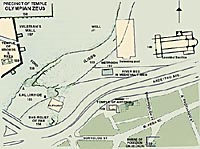

After 'the Persian business', there was a spate of building in Athens and Attica. That these construction programmes went ahead was a reflection of the city's ambition to become a major power in the land. But we should not forget that there were leading politicians intent on linking their own names with important buildings. This was nothing new in Athens; but it was the first time it had been seen on such a scale. It had to do not only with maintaining the domestic balance, but with external policy. The people behind these programmes were three men who left their stamp on the political and social life of Athens across half a century - Themistocles, Cimon, and Pericles.
It was at this time that the shrine and garth of Theseus were put up, to house the mortal remains of the hero Theseus which Cimon had brought back from the island of Scyros. Their site has not been identified with any certainty. It was at this time, too, that the temple of Artemis at Melite was rebuilt and the Telesterium of the Great Gods was repaired at Phlya.
With Persian spoil, a temple of Euclea -
usually identified with Artemis - was built on the north
slope of the Acropolis in the middle years of the The grandiose
buildings on the Acropolis itself, and the four great
temples - to Hephaestus at
Colonos-in-the-Agora, to Poseidon at Sunium, to Nemesis
at Rhamnus, to Ares at Acharnae - were
important |
  |
 |
The furious building boom of the 5th century
was succeeded by relative stagnation in the |
 |
 |
|
| |
|||
| |||